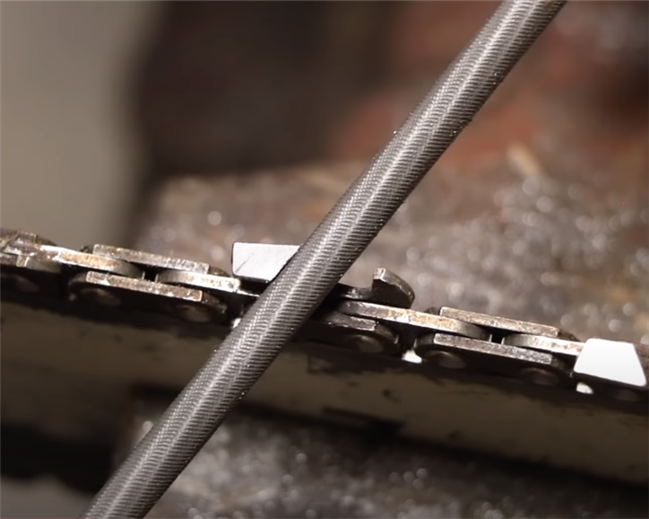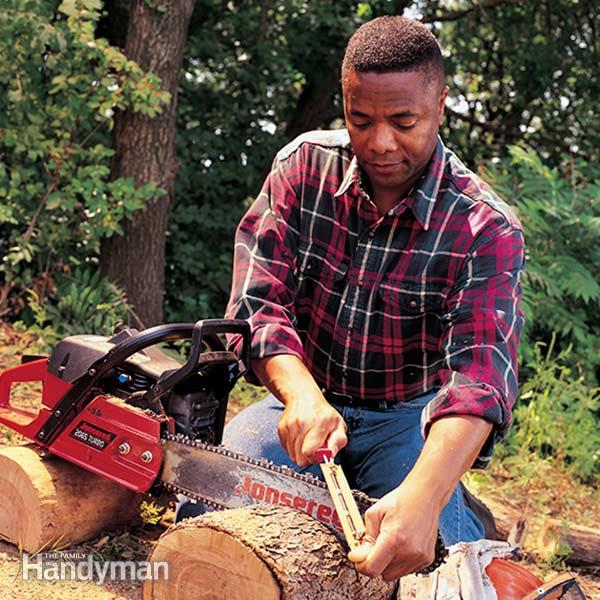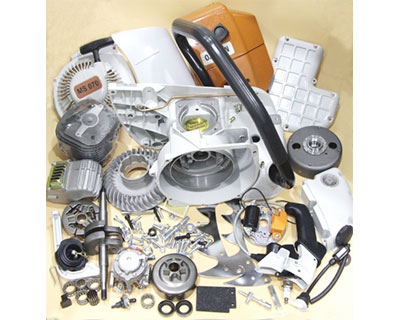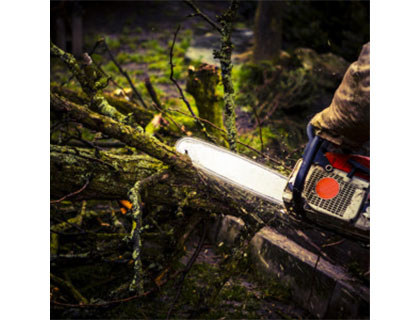![]()
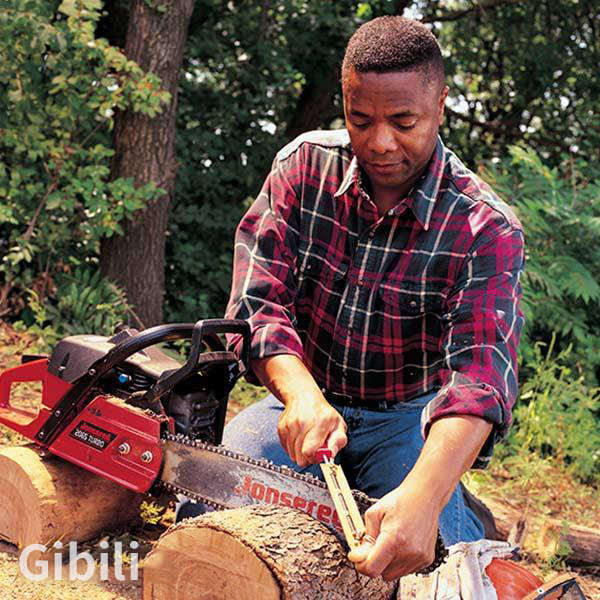
Is your dull chain saw blade burning and bucking its way through the wood? It's a slow way to cut. It's also a dangerous way to cut. Here's how to sharpen your chain saw blade and cut more quickly—and avoid messy chain saw accidents.
A dull chainsaw blade can cause burning and buckling while sawing through wood, and it’s a slow and dangerous way to cut. Here are some lessons on how to use a chainsaw sharpener from Gibili Power Tacke:
1. Things you’ll need: A pair of gloves and a filing kit made for chainsaws, which are available outdoor power equipment stores.
2. Engage the chain brake and lightly clamp the bar in a vice.
3. Place the guide between the rivets on the chain, with the arrows on the guide pointing toward the nose of the bar.
4. Follow the angle of the top plate of the cutter; the rollers on the guide keep you from going too deep into the side plate of the cutter.
5. Use steady, even strokes with the file – 2 or 3 strokes until the face of the cutter is shiny silver.
6. After sharpening a couple of the cutters, release the chain brake and rotate the chain forward to expose more cutters to sharpen. Then reset the brake.
7. When you’re done sharpening the cutters on one side of the chain, flip the chainsaw around so you can sharpen the cutters on the other side of the chain.
8. Use the depth gauge tool and file to adjust the height of the depth gauges on the chain. If the depth gauges are too high, the cutters can’t reach the wood.
9. Re-sharpen your chain every time you refill your chainsaw with fuel.
10. Keep your chain out of the dirt when cutting or it will dull quickly.
Sharpening a chainsaw isn’t scary
A chainsaw’s nasty-looking cutters can scare you into thinking you can’t sharpen the saw yourself. But in about 10 minutes, with the help of a couple of inexpensive files and guides, you can transform your slow-cutting chainsaw into a firewood-cutting ninja. You can sharpen the chain right on the saw and right by the wood you’re cutting. Do it often, and you’ll get years of sharp cutting life from your chain. Here, we’ll show you how to use chain saw sharpeners.
When to sharpen
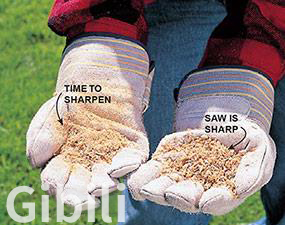
Photo 1: Check the waste to tell if it’s time to sharpen
Check the waste material from your saw cuts. Dust means it’s time to sharpen. Chips indicate that the cutters are sharp.
A sharp chain cuts well with very little force on the bar, while a dull chain tends to ride in the cut without deepening it. If you’re forcing the saw to persuade it to cut, the chain is dull and needs sharpening. Also, when the chain spits out dust instead of chips (Photo 1), it’s time to grab a round file and sharpen the cutters. A dull chain is dangerous—it greatly increases the chances of kickback. The chain is more likely to catch in the material and propel the bar up toward the operator. (read Using a Chain Saw Safely, for more information).
Chain anatomy

Photo 2: The three parts of the blade that get sharpened
Inspect the cutters (saw teeth) on your chain loop. The semicircular cutting edges can be quickly sharpened and reshaped with a round file. A depth-gauge fin in front of each cutter controls how deep the cutter bites into the wood. The angles ground on the cutters alternate between left and right to keep the saw cutting straight.
The cutters on a chain have semicircular cutting edges in specific diameters; to sharpen them, use a round file of the same diameter (Photos 2 and 3). In front of each cutter is a “depth gauge,” a piece of metal shaped like a shark fin. The depth gauge’s tip is a hair shorter than the tip of the cutter and controls how deep the cutter can bite. After repeated sharpenings, the cutters can become level with the depth gauges—and keep the saw from cutting. It’s easy to lower the depth gauges to the right height with a flat file and file guide (Photo 6).
Sharpening is easy if the cutters have dulled from normal use. If the cutters are nicked badly from accidental contact with rocks, dirt or objects embedded in trees, you may need to have the chain professionally sharpened or buy a new one.
Tools for sharpening
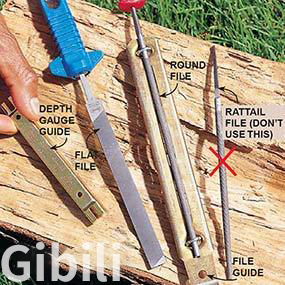
Photo 3: Tools to get—and not to get
Buy four tools for freehand to use as a chainsaw sharpener: a round file with file guide to sharpen the cutters, and a flat file with a depth-gauge guide for lowering the depth gauges. Don’t use a rattail file on your cutters!
You’ll need:
l A round file that matches the cutter diameter (Photo 3). Popular diameters for medium-duty chainsaws are 5/32, 3/16 and 7/32 in. Check the owner’s manual for your saw’s requirements, or use the chain identification number stamped on the drive link (Photo 2). Small-engine dealers and hardware stores have charts to match this number with the right file diameter.
Caution: Don’t use a standard rattail file for as a chainsaw sharpener. Its tapered diameter and coarse teeth will ruin your chain’s cutters.
l A file guide. It holds the round file at a uniform depth as you sharpen each cutter.
l A flat file and gauge for occasional resetting of the depth gauges.
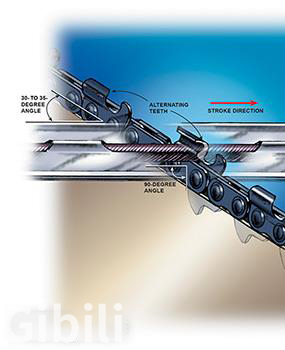
Fig. A: File at the right angles
First, mount your round file (it’s the right size, right? And no rattail files) in the file guide. Then hold the file at a 30- or 35-degree angle (check your saw’s cutters) to the bar horizontally and at a right angle vertically. Now start filing. Count your strokes, and use the same number of strokes on each cutter.
Sharpening by hand
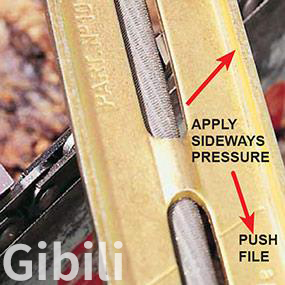
Photo 5: Look through the file guide
Look through the file guide to line up the cutter with the file. You’ll feel the file nest into the cutter. File every other cutter and then move to the other side of the bar to sharpen the rest.
As you work, you’ll need to advance the chain after sharpening every five or six cutters. Wear gloves for this. However, while filing the cutters, you may find you have a better “feel” for the contact between the file and cutter if you work barehanded.
Cut a 2-in. deep kerf in a log and rest the saw bar in it to secure it while sharpening. Place the file and file guide into a cutter on the top and near the end of the bar; mark the top of this cutter with a felt-tipped pen to indicate where you began using a chainsaw sharpener. Line up the file with the factory-ground angle on the cutter. This is almost always 30 or 35 degrees. Most file guides have 30- and 35-degree angles etched on their upper side to help you preserve the angle as you file.
Make a stroke, maintaining the proper angle on the cutter, parallel to the ground and away from your body. You’ll feel the guide riding on top of the cutter and depth gauge. The first couple of strokes on a dull cutter may vibrate your hand a little. Make five or six outward strokes, and then stop. When you feel a burr along the cutter’s outer edge, the cutter is sharp.
The cutting angles on the cutters reverse direction every other tooth, so skip a cutter and file the next one the same number of strokes as the first. Always file so the burr is formed on the outside edge of the cutter. After you sharpen five or six cutters, put on gloves and pull the chain along the bar to expose the next batch of cutters. Continue sharpening cutters until you reach the one you marked, then move to the other side of the saw bar and sharpen the opposite-angled cutters, again using the same number of strokes per cutter.
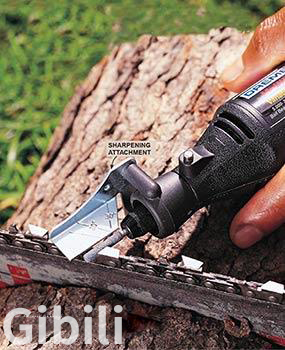
Quick and easy power sharpening
You can save time and energy by using a rotary tool to sharpen the cutters. The Dremel A679-02 chainsaw chain sharpener(available through our affiliation with amazon.com) comes with three grinding wheels in popular diameters and a guide that quickly screws onto the rotary tool to control the cutting depth and angle (it also comes with a stone and guide for sharpening lawn mower blades). Be sure to wear safety glasses while using it.
Place the grinding wheel against the cutter with the edge of the metal guide parallel to the cutter’s factory-ground angle, turn on the tool, and grind the cutter with sideways pressure to the count of four. Sharpen every other cutter as you would by hand with a round file, then switch and do the opposite cutters. When you get used to sharpening with a rotary tool as a chainsaw sharpener, you can leave it running as you move from cutter to cutter to make sharpening go even faster. The Dremel manual explains how to lower the depth-gauge fins with the grinding wheel.
Filing depth gauges
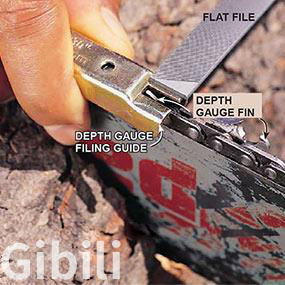
Photo 6: Check depth gauge heights
Check the height of the depth gauges with the filing guide each time you sharpen. When they protrude above the guide, file them flush with a flat file.
Old saws on sharpening chainsaws
l If your saw pulls to the side when cutting, it’s because the cutters on that side are sharper than those on the other side. To keep your saw cutting in a straight line, be a fanatic about filing each cutter with the same number of strokes and the same amount of pressure.
l Cutters can be sharpened up to 10 times or more before the chain needs replacing. If your cutters are worn unevenly after a few sharpenings, a professional can regrind them to uniform shape.
l If you use the same chain for a few years, then buy a new one, the new one won’t mesh smoothly with the sprocket and bar. It’ll cause rougher cutting and faster wear on the saw. Bob Tacke, chainsaw expert, advises: “Buy two extra chains and switch off among the three occasionally. This way all the components of the cutting train—bar, sprockets and chains—will fit together and prolong the life of your saw.”
l File guides that clamp to the bar will ensure that you file the same angle on each cutter. They take a little longer to use, but they restore the cutting edge to the exact factory-ground angle, so there’s less chance you’ll need to have your chain reground by a professional sharpener.
l When in doubt, take your chain to a pro. A pro will use a power chainsaw sharpener that resembles a mini-compound miter saw to precisely regrind each cutter to a uniform depth and cutting angle.
Additional Information
l Figure A: Sharpening detail
l Required Tools for this Project
l Have the necessary tools for this DIY project lined up before you start—you’ll save time and frustration.
l Depth gauge guide for sharpening chain saw blades
l Dremel tool
l Dremel tool blade sharpening kit No. A679-02
l File guide for sharpening chain saw blades
l Flat file
l Round file






